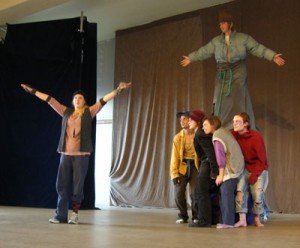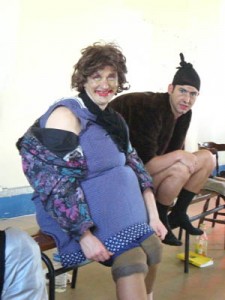Bouffons
The word ‘Bouffon’ comes from a Latin verb: buffare, to puff (i.e. to fill the cheeks with air). When we blow up our cheeks, and assume a physical attitude, we observe an ancient ritualistic practice of human beings: to deform themselves, to swell in order to provoke a response from their audience.
Origins of Bouffon
 And so the story goes…In Medieval Europe, lets say mid 16th Century, people were exiled for being ‘different’. They tended to be: the disabled, the mentally ill, the disfigured, the homosexual, the old and infirm, the racially different, wayward women, sexual deviants, religious minorities, illegitimate children, transvestites and those with radical points of view. All others in society were considered ‘the beautiful people’. The exiled were ejected from within the city walls and cast out to the swamps to fend for themselves in rancid waters that rotted their flesh and drowned them in filth. It was a pitiful life but they had nowhere else to go, and so there they would stay but for once a year when they were invited back inside the city for the annual hock-tide celebration. This was not a purely charitable invitation though- it gave ‘the beautiful people’ an occasion to look down upon the exiles and laugh at them, reasserting their own position in society and their feelings of superiority. At the same time, this once yearly celebration afforded the exiles the opportunity to challenge the authority of ‘the beautiful people’- to expose them to the reality of who they are and what they’ve become- mindless conformists. The exiles had to be extremely careful not to upset or provoke ‘the beautifuls’ as they were not protected by laws and were thus subject to whimsical killings or flagrant murder. At all times they had to make sure they were loved by the beautiful people, whilst simultaneously parodying their cultural beliefs and personal traits. Thus, their aim was to provoke a pleasured response through their presence and performance, whilst indirectly translating the cruelty of human sociality and the victims that are created in the struggle to be beautiful. In this way, the exiles were the original grotesque clowns, they were the Ancient Bouffons.
And so the story goes…In Medieval Europe, lets say mid 16th Century, people were exiled for being ‘different’. They tended to be: the disabled, the mentally ill, the disfigured, the homosexual, the old and infirm, the racially different, wayward women, sexual deviants, religious minorities, illegitimate children, transvestites and those with radical points of view. All others in society were considered ‘the beautiful people’. The exiled were ejected from within the city walls and cast out to the swamps to fend for themselves in rancid waters that rotted their flesh and drowned them in filth. It was a pitiful life but they had nowhere else to go, and so there they would stay but for once a year when they were invited back inside the city for the annual hock-tide celebration. This was not a purely charitable invitation though- it gave ‘the beautiful people’ an occasion to look down upon the exiles and laugh at them, reasserting their own position in society and their feelings of superiority. At the same time, this once yearly celebration afforded the exiles the opportunity to challenge the authority of ‘the beautiful people’- to expose them to the reality of who they are and what they’ve become- mindless conformists. The exiles had to be extremely careful not to upset or provoke ‘the beautifuls’ as they were not protected by laws and were thus subject to whimsical killings or flagrant murder. At all times they had to make sure they were loved by the beautiful people, whilst simultaneously parodying their cultural beliefs and personal traits. Thus, their aim was to provoke a pleasured response through their presence and performance, whilst indirectly translating the cruelty of human sociality and the victims that are created in the struggle to be beautiful. In this way, the exiles were the original grotesque clowns, they were the Ancient Bouffons.
 The usage of the word Bouffon comes from the French language and was first used in a theatrical context by Jacques Lecoq in the early 1960s at his school (L’Ecole Internationale de Théâtre Jacques Lecoq) in Paris. Through his pedagogic approach to performance and comedy, he created dynamic classroom exercises that explored elements of burlesque, commedia dell’arte, farce, gallows humor, parody and satire.
The usage of the word Bouffon comes from the French language and was first used in a theatrical context by Jacques Lecoq in the early 1960s at his school (L’Ecole Internationale de Théâtre Jacques Lecoq) in Paris. Through his pedagogic approach to performance and comedy, he created dynamic classroom exercises that explored elements of burlesque, commedia dell’arte, farce, gallows humor, parody and satire.
“The difference between the clown and the bouffon is that while the clown is alone, the bouffon is part of a gang; while we make fun of the clown, the bouffon makes fun of us. At the heart of the bouffon is mockery pushed to the point of parody. Bouffons amuse themselves by reproducing the life of man in their own way, through games and pranks. The parody isn’t directly offensive with regard to the public; there is no deliberate intention to mock—the relation is of a different order. Bouffons come from elsewhere.”
Jacques Lecoq – “Theatre of Movement and Gesture” 2006 (Trans. David Bradbury)
There are also echoes of the ancient bouffon in the paintings of Hieronymus Bosch and in the plays of Aristophanes.
Bouffon & Aqueous Humour
 Tom Hogan was first introduced to the Bouffon clown when he performed in a piece for Streets Ahead that was commissioned by Romiley Forum and directed by Commotion performers Siobhan Rocks and Alex McDonald. Tom said “We came to the understanding that the Bouffon represents the outcast, the one who fails to uphold the social etiquette expected from an integrated and fully functional member of society. They speak for the excluded, the shunned, and untouchable: those that we ignore because of our embarrassment and guilt. We realise that our position in society is upheld by those we consider to be lesser or greater than ourselves. Bouffons challenge our position in society through parody and satire, holding up a mirror to moralising, judgmental, social airs and graces.”
Tom Hogan was first introduced to the Bouffon clown when he performed in a piece for Streets Ahead that was commissioned by Romiley Forum and directed by Commotion performers Siobhan Rocks and Alex McDonald. Tom said “We came to the understanding that the Bouffon represents the outcast, the one who fails to uphold the social etiquette expected from an integrated and fully functional member of society. They speak for the excluded, the shunned, and untouchable: those that we ignore because of our embarrassment and guilt. We realise that our position in society is upheld by those we consider to be lesser or greater than ourselves. Bouffons challenge our position in society through parody and satire, holding up a mirror to moralising, judgmental, social airs and graces.”
Tom got to grips with Philip Gaulier’s stripped back, purified version of Lecoq’s Bouffon style whilst attending his school in 2008. In reflecting on his notes, Tom found he had scribbled down the following, which he thought succinctly summarises Gaulier’s interpretation of Bouffon: “making the beautiful people laugh is the weapon and it’s aim is to kill by asphyxiation in the laughter or by turning the joke so that they realise that they are laughing at themselves and in the horror of their reflected image they have a heart attack and die”.




